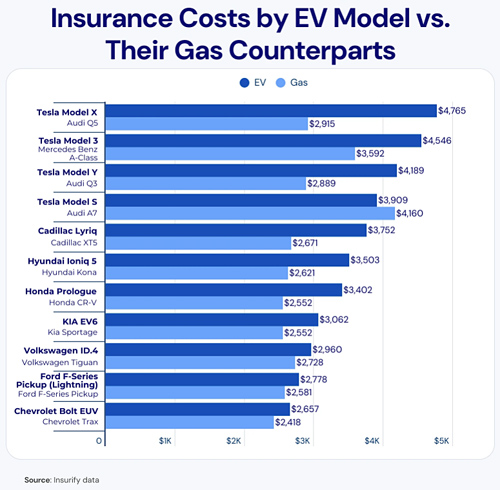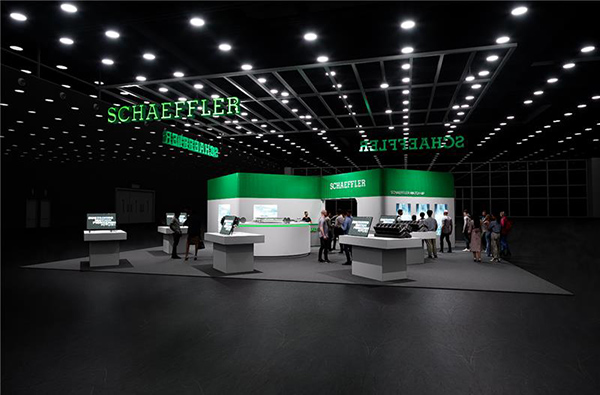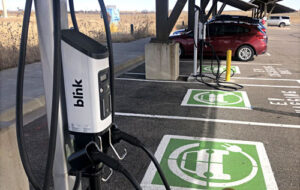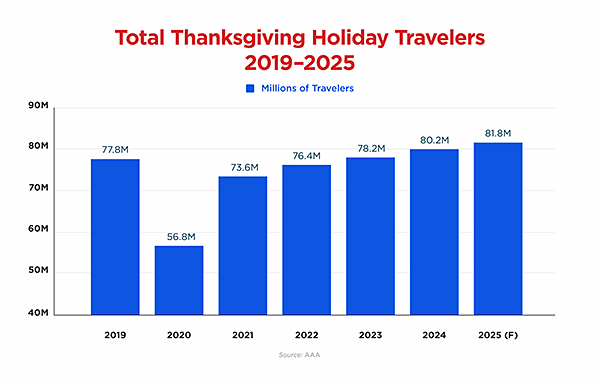See 10 states where it is significantly more to insure EVs, and 5 states where it’s least to insure compared to gas-powered cars — and why
Cambridge, Mass.—The average cost of car insurance has remained relatively steady over the last year, according to Insurify’s auto insurance report. But electric vehicle (EV) drivers have experienced a rise by 16% over the past 12 months.
Drivers pay 49% more to insure EVs than gas-powered cars. EV drivers face an average insurance cost of $4,058 per year. By comparison, the average cost to insure a gas-powered vehicle is $2,732, per Insurify data. The higher cost of repairing and replacing EVs can account for much of that difference.
EV adoption and related factors, like charging infrastructure, incentives, and the availability of specialized technicians, also affect insurance costs by influencing maintenance and ownership costs.
EV buyers have been able to save up to $7,500 with the federal EV tax credit. But the credit expires on Sept. 30. The loss of the tax credit could hinder further EV adoption and lead to rising insurance premiums.
Key findings
- The average annual cost of insuring an EV is $4,058 — 49% higher than the average to insure a gas-powered car.
- The Tesla Model X and Model 3 are the most expensive EVs to insure. The Model X has an average annual cost of $4,765 for full coverage, an increase of 36% since last year.
- Full-coverage car insurance for EVs costs up to 99% more than for gas-powered cars in Arkansas, Pennsylvania and Idaho. Low adoption rates and minimal EV infrastructure are primary cost drivers.
- Drivers in New Jersey and California pay 15% to 31% more to insure an EV compared to a gas-powered car. High adoption rates, expanding EV infrastructure, and strong state-specific financial incentives account for the smaller price difference.
Tesla’s EVs most popular, but most expensive to insure
While EVs often come with a higher insurance cost, Insurify data shows that Tesla EVs top the list. The Tesla Model X, a luxury SUV with falcon-wing doors, is Tesla’s most expensive model, according to Kelley Blue Book (KBB). It also has the highest average insurance costs.
A 2025 Tesla Model 3 costs around half the price of a 2025 Tesla Model X, according to KBB. But Insurify data shows it’s still the second most expensive EV to insure. While its battery has a slightly lower range and about half to three-quarters the capacity of the Model X, its technology is still costly to repair.
Claims data can shed light on insurance costs, too. The average claims frequency for a repairable, collision-damaged EV is 3.12% for the first quarter of 2025, according to auto insights company Mitchell. But the claims frequency for the Tesla Model 3 is 26.95%, signaling to insurers that these models require frequent repairs. The claims frequency for the Tesla Model X is 3.68%, considerably closer to average.
The Tesla Model Y and Model S are the next most expensive EVs to insure. The Model S is a much more expensive car than the Model Y, but it has a claims frequency of 29.47%, compared to the Model S’s claims frequency of 5.22%.
Insurify data shows that these EVs are 26% more expensive to insure on average than comparable vehicle makes and models.
10 states where it is significantly more to insure EVs
Severe weather, vandalism and theft affect premiums for all vehicles. Adoption rates also affect EV insurance costs. Fewer EVs in an area means less experience with how much claims will cost, and to protect themselves, insurers estimate costs will be high and set premiums accordingly.
1. Arkansas
- Cost difference of insuring an EV vs. a gas-powered car: 99%
- Average annual premium for EVs: $4,817
- Average annual premium for gas-powered cars: $2,415
Though Arkansas’ EV registration has grown significantly in the past few years, the state’s adoption rate is still comparatively low. About 0.27% of registered vehicles in Arkansas are EVs, according to the most recent data from the U.S. Department of Energy (DOE). The nationwide adoption rate is 1.24%.
“If there were a higher adoption rate, there would be more incentive to open shops that work on EVs,” said Daniel Lucas, carrier relations manager at Insurify. “Arkansas doesn’t have as many EV repair shops as California, for example, which can lead to higher repair costs and rental fees because of the longer wait time.”
Barriers to adoption persist, and two plans for funding charging stations statewide have either run out or stalled. Tesla also doesn’t operate a store in Arkansas, limiting the number of EV models available.
Arkansas faces severe weather risks, notably tornadoes, hail and lightning. Comprehensive insurance covers a windshield replacement due to hail damage, but sensors and cameras in the windshields of most EVs can make that repair much more expensive.
2. Pennsylvania
- Cost difference of insuring an EV vs. a gas-powered car: 99%
- Average annual premium for EVs: $4,598
- Average annual premium for gas-powered cars: $2,314
Pennsylvania is taking steps to reduce barriers to EV ownership. The state offers rebates for new and one-time pre-owned alternative fuel vehicles. Drivers can apply for rebates of $500 to $3,000, and low-income households may receive an additional $1,000.
Pennsylvania also has 90 charging station projects underway. Of those, 17 opened before the federal government paused funding for the National Electric Vehicle Infrastructure (NEVI) program.
Pennsylvania’s EV adoption rate is 0.69%, per the DOE, just above half of the U.S. average. EV registrations are mainly in counties with urban areas, especially around Philadelphia and Pittsburgh, according to the Pennsylvania Department of Transportation.
Auto insurance is often more expensive for any vehicle type in urban areas, given the increased risk of collisions, theft and vandalism.
3. Idaho
- Cost difference of insuring an EV vs. a gas-powered car: 95%
- Average annual premium for EVs: $3,332
- Average annual premium for gas-powered cars: $1,708
Idaho is investing in EV infrastructure alongside other states. Idaho submitted a NEVI proposal to install five fast-charging stations along major roadways, adding to a growing network. But the federal government paused the program for review before project work could begin.
Idaho’s EV adoption rate is relatively low, at 0.43%. But migration from California may explain why Idaho is backing EV infrastructure, even with low statewide adoption. Former Californians accounted for 6.2% of Idaho’s migration-related population growth in 2023, according to the American Community Survey. Former Washington residents come in second, accounting for 5.3%.
California and Washington have the highest EV adoption rates in the country, at 3.41% and 2.23%, respectively, according to the DOE. But infrastructure takes time, and EV drivers moving to Idaho may see higher insurance rates as the state hurries to catch up.
4. Iowa
- Cost difference of insuring an EV vs. a gas-powered car: 87%
- Average annual premium for EVs: $3,354
- Average annual premium for gas-powered cars: $1,793
Iowa’s low EV adoption rate of 0.29% and the limited number of specialized technicians likely contribute to Iowa drivers paying more to insure an EV. Iowa awarded funding to install 28 charging stations along interstates last October, but the funding pause has the projects on hold.
All Iowa drivers pay higher insurance rates due to severe weather, especially hailstorms and tornadoes. In 2024 alone, Iowa experienced 330 severe hailstorms, including 37 with hail 2 inches or larger, and 15 extremely severe tornadoes, the National Oceanic and Atmospheric Administration (NOAA) reported.
Iowa also saw a 12% increase in traffic fatalities between 2022 and 2023, according to the National Highway Traffic Safety Administration (NHTSA).
“Elevated risk, a higher-priced car that’s more expensive to repair, and fewer places to fix it can raise insurance costs,” Lucas said.
5. Delaware
- Cost difference of insuring an EV vs. a gas-powered car: 76%
- Average annual premium for EVs: $5,840
- Average annual premium for gas-powered cars: $3,310
Delaware’s EV adoption rate is closer to the national average, at 0.92%. The state has a rebate program for eligible new and used EVs and for installing charging stations for public access, fleet or workplace use, and multi-family dwellings. Multi-family homes in priority areas can get a 90% reimbursement for certain installations.
Delaware is actively expanding its EV charging infrastructure and received most of its NEVI funding before the federal government paused the program. The state’s high population density also increases the chance of a car accident, which insurers consider when setting rates.
6. Louisiana
- Cost difference of insuring an EV vs. a gas-powered car: 72%
- Average annual premium for EVs: $5,197
- Average annual premium for gas-powered cars: $3,015
Louisiana also experiences severe weather, increasing the likihood of claims. EV insurance rates may drop over time as a more extensive claim history becomes available, according to the National Association of Insurance Commissioners (NAIC). But Louisiana’s low adoption rate of 0.22% means insurers lack robust regional data on accidents and battery replacements.
7. Indiana
- Cost difference of insuring an EV vs. a gas-powered car: 71%
- Average annual premium for EVs: $3,520
- Average annual premium for gas-powered cars: $2,061
Indiana’s EV adoption rate is relatively low, at 0.42%. But like other states, Indiana plans to use the NEVI funding — if available — to install EV charging stations across the state. Several area utility companies offer rebates to commercial and residential customers for installing a charging station, but the state doesn’t offer incentives.
The ease of buying an EV may also affect adoption and, in turn, insurance costs in Indiana. In most states, franchise laws forbid automakers from selling directly to consumers, favoring the traditional dealership model. Tesla gets around this somewhat by operating “stores,” and it has only two in Indiana, both in the Indianapolis area.
8. Nevada
- Cost difference of insuring an EV vs. a gas-powered car: 70%
- Average annual premium for EVs: $5,791
- Average annual premium for gas-powered cars: $3,403
Nevada is the first state on this list to have an adoption rate higher than the U.S. average, at 1.85% of vehicle registrations. Las Vegas alone is home to 1,397 public charging stations, according to ChargeHub, suggesting EV infrastructure supports higher adoption.
But Nevada is also among the most expensive states for car insurance. A high vehicle theft rate contributes to these higher premiums for EVs. Nevada had the fifth-highest vehicle crime rate in 2024 and the third-highest rate in 2023.
9. New Mexico
- Cost difference of insuring an EV vs. a gas-powered car: 70%
- Average annual premium for EVs: $3,597
- Average annual premium for gas-powered cars: $2,117
New Mexico’s EV adoption rate is 0.52%, which is relatively low for the region. And the state has only two Tesla stores. But a new state law requires 43% of new cars shipped to New Mexico dealerships in 2026 to be zero-emission vehicles. New Mexico also offers a tax credit of up to $3,000 for buying an EV and an additional $400 credit for installing a charger at home.
New Mexico is also among the states with the highest poverty rate in the U.S., according to the U.S. Census Bureau. This could mean the higher costs associated with EVs present a significant barrier to higher adoption in the state.
New Mexico also had the third-highest vehicle theft rate in 2024, increasing statewide claims costs.
10. Florida
- Cost difference of insuring an EV vs. a gas-powered car: 66%
- Average annual premium for EVs: $5,283
- Average annual premium for gas-powered cars: $3,189
Florida’s EV adoption rate is 1.37% — higher than the U.S. average — and the charging infrastructure reflects that. Orlando has 1,194 public charging stations, and Miami has 1,144. Florida is also home to 28 Tesla stores.
Florida is among the 10 most expensive states for car insurance, according to Insurify’s report. Severe weather, high insurer losses and insurance fraud, especially for auto glass claims, have contributed to rising auto insurance rates statewide. Given the increased cost of repairs for EVs, any factor affecting claims frequency and cost can significantly affect EV car insurance rates.
5 states where it’s least to insure EVs compared to gas-powered cars
In certain states, EV popularity, state incentives and developing charging networks have begun bringing EV insurance costs more in line with standard auto insurance. Still, paying 15%–37% more for anything is a notable increase.
1. New Jersey
- Cost difference of insuring an EV vs. a gas-powered car: 15%
- Average annual premium for EVs: $3,563
- Average annual premium for gas-powered cars: $3,095
Several factors explain why New Jersey drivers pay the smallest difference between insuring an EV and a gas-powered car. New Jersey has its own EV incentive, in addition to the soon-to-end federal EV tax credit program.
Drivers can immediately apply a $1,500 credit when buying or leasing a new EV. Plus, income-eligible drivers can qualify for up to $4,000. Property owners can also receive $250 to install a charger at their home.
New Jersey’s EV adoption rate is also above the U.S. average, at 1.84%, per the DOE. And it’s easier to buy and charge EVs. The state is home to eight Tesla shops, with more nearby in Philadelphia and New York City. It also has a growing EV charging infrastructure, concentrated in urban areas.
2. California
- Cost difference of insuring an EV vs. a gas-powered car: 31%
- Average annual premium for EVs: $3,827
- Average annual premium for gas-powered cars: $2,924
California has the highest EV adoption rate in the country, at 3.41%, which leads to many specialized EV technicians and more charging stations, lowering financial and emotional costs. The number of gas-powered cars on the road will peak this year in California, according to an analysis from Recurrent, as gas cars exit operation and EV sales grow.
Though funding has run out for certain rebates, California has a history of offering financial incentives at the state and municipal levels to reduce the cost of buying an EV or installing a home charger. And California already has more charging stations than gas stations.
3. Maryland
- Cost difference of insuring an EV vs. a gas-powered car: 35%
- Average annual premium for EVs: $6,142
- Average annual premium for gas-powered cars: $4,555
Maryland is the most expensive state for car insurance. The high rate of car thefts in Maryland and specific state policies increasing insurers’ financial risk have led to higher rates across the board.
But its 1.37% adoption rate and growing EV availability and charging infrastructure have likely helped close the price gap between insuring an EV and a gas-powered car. Maryland also offers an EV tax credit for up to $3,000.
Maryland’s EV registrations are concentrated in densely populated areas, like Montgomery County, outside Washington, D.C., and Baltimore. Since car insurance is typically more expensive in urban areas, the higher financial risk of insuring an EV may drive up premiums.
4. Illinois
- Cost difference of insuring an EV vs. a gas-powered car: 37%
- Average annual premium for EVs: $3,342
- Average annual premium for gas-powered cars: $2,447
Illinois’ EV adoption rate is 0.89%. The state is aggressively investing in EV accessibility and infrastructure. Illinois has distributed 11,309 rebates to EV drivers since 2022, according to the Illinois Environmental Protection Agency.
Drivers can get a $4,000 rebate for buying an EV and a $1,500 rebate for purchasing an all-electric motorcycle.
Before the federal government paused NEVI funding, Illinois awarded grants to construct 182 new charging ports around the state. Several utility companies have also pledged funding for boosting EV fleet vehicle purchases, building charging stations, or offering incentives for installing home charging, sharing EV charging data, and shifting electrical usage.
5. Arizona
- Cost difference of insuring an EV vs. a gas-powered car: 37%
- Average annual premium for EVs: $3,043
- Average annual premium for gas-powered cars: $2,221
Arizona doesn’t offer EV rebates, but it does have a few incentives that may have helped the state achieve a 1.33% adoption rate. These include allowing EV drivers to park in designated carpool spaces, use the HOV lane, and qualify for tax exemptions, according to Electrify Arizona.
Arizona is also building out its charging infrastructure and has awarded NEVI funding to construct 89 EV charging ports. The Salt River Project, a nonprofit water and energy provider in Arizona, has also created an incentive program of $1,500 to $20,000 for nonprofits, businesses, government agencies, multifamily housing complexes and schools to install EV charging stations.
Why it costs more to insure an EV
EVs cost 22% more to repair than gas-powered cars. The average price of a new EV was $57,734 in June, while the average for gas-powered vehicles was $48,799, according to KBB. In the event of a total loss, insurers could pay an average of 18% more to replace an EV.
EVs require more mechanical labor hours as well: 3.04 hours vs. 1.66 for gas-powered cars, Mitchell reported last year. Because many EVs require original manufacturer parts, technicians can’t pull from a vast inventory of aftermarket and recycled parts, which often lowers repair costs for gas-powered cars.
Many newer cars, not just EVs, have technology that makes them more expensive to insure and repair. Advanced driver assistance systems (ADAS) often include multiple sensors and cameras and are vulnerable to even minor collision damage.
EVs have the added element of a specialized battery that can be very expensive to replace. Tesla batteries, for example, are a structural part of the car and more costly to repair. But average EV battery prices are falling, and a 2024 report from Goldman Sachs projects prices will continue to fall over the next five years.
Elimination of the EV tax credit may affect adoption
The EV tax credit of $7,500 for new cars and $4,000 for used cars will expire on Sept. 30. While some states have incentives to lower the purchase price, eliminating the federal EV credit means ending a strategy that helped reduce the up-front cost difference between EVs and gas-powered cars.
In a recent Insurify survey of members of Gen Z, 44% of respondents said eliminating the EV tax credit will affect their decision to buy an EV. Gen Z accounts for 25% of EV drivers, second behind Millennials’ 41%.
Eliminating the credit will slow EV adoption considerably, though how much remains to be seen, Dr. Tim Lipman, co-director of the Transportation Sustainability Research Center at the University of California, Berkeley, told Insurify.
“Hopefully, bringing more lower-cost models onto the market in the next few years will help to mitigate this and give middle-income households more options, [since] low-income households rarely buy new cars of any type,” he said.
While EVs’ initial costs are usually higher, they need maintenance and service less frequently than gas-powered cars, which can bring down costs. Less expensive fuel requirements can also make an EV cheaper in the long run.
“EVs don’t require oil changes, have fewer moving parts, and electricity is usually less expensive per mile than gasoline — particularly if you can charge at home,” Liz Najman, director of market insights at Recurrent, told Insurify. “The break-even point — when owning an EV becomes more cost-effective than a comparable gas car — varies depending on local energy costs, incentives, and how much you drive.”
Bushell said many other factors will eventually lower EV ownership costs.
“The sticker price of EVs is being decreased by powerful forces even without federal tax credits,” he said. “The greatest of them is the declining cost of battery production. An EV has 30% to 50% of its cost in batteries.”
Bushell called out the scale of production, state and local incentives, expanding public charging infrastructure, and battery recycling as key elements of long-term EV affordability.















Comments are closed.